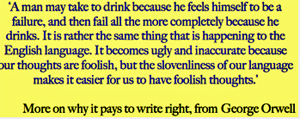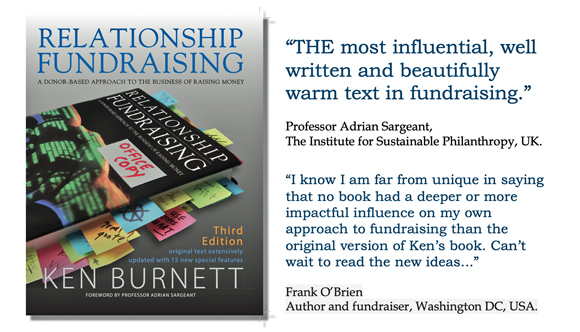| |
And while on SOFII read about the adventures of new trustee Warren, in What makes an effective board
part 1.
part 2. |
|
Of course we should question everything and assume nothing. But the questions fundraisers ask at times miss the point, sometimes by several miles. Like the perennial, ‘how long should a letter be?’, we will often find the answer to our most fundamental questions just by asking ourselves if it’s the right question, or not.
I’m as guilty as the next person. One of the first public seminars I ever did was called Direct Mail; the last unexplored frontier of fundraising. This was in 1983 and George Smith and I thought we were talking about something new for UK fundraisers. How foolish we were (though we filled the hall with paying customers, who were at least no better informed than we were). Now, thanks to SOFII, I know many fundraisers were well ahead of George and me back then, writing brilliantly crafted direct mail appeals even hundreds of years before us (see Eihei Dogen’s letter on SOFII, and some from the brilliant Dr Barnardo). This seems to me a clear example of that widespread and expensive fundraising foolishness, which we call ‘constantly re-inventing the wheel’.
The issue back then wasn’t whether the medium is new or not, or thriving or dying, but how to do it properly. It’s the same today. The medium is not the message. It’s not even the point. So why do fundraisers persist in confusing the two? The medium is merely a means to an end – delivering our message. It’s the message that we should be focussing on.
Ever since that seminar back in 1983 I’ve heard people predicting the decline and demise of direct mail in the face of new alternative media that the public will supposedly prefer. I never thought it likely, and – email, twitter, texting and all the rest included – I personally find direct mail today to be in rude good health, as ever.
It’s a bit like the constantly-ventured supposition that the printed page will disappear in the face of electronic media. Yet, today, more books are printed than ever before. And it’s the same thing as the assumption that quality writing, sound grammar and the precise use of language will wither and die in the face of instant texting, blogging, e-messaging and similar abominations of our modern age.
This last one is a bit of a worry though, simply because it is evident that all around us now there is so much poorly crafted writing, pervading all aspects of our lives.
This merely shows that good communication, written and verbal, is likely to be dismissed or at best pushed aside by lazy, unprofessional people who prefer to take an easier shortcut. Invariably though, experience shows us that their communications do not endure. The shortcut is easier for them, but not for their readers. As the poet John Donne said, ‘that which is written with ease is read with difficulty.’ Or as George Orwell put it (and I paraphrase), ‘think sloppy and you will write sloppy, and vice versa.’
Remember these aphorisms, dear reader. They will serve you well down the years. There is a real opportunity for you, here.
Sorry, I don’t mean to be patronising. But I find you either know (or get) this stuff, or you don’t. I have been a consultant on fundraising communication for more than 25 years. The most common question I get from clients and potential clients still is, ‘Will this work, for me?’ ‘This’ can be the latest fundraising fad, direct mail, e-mail newsletters, legacy marketing, face-to-face, capital campaigns or whatever. It really doesn’t matter. My answer is always the same. I say, ‘It will work if you do it properly. It won’t work if you don’t.’
This I think is sound advice. But only a minority actually listen.
At its heart direct mail fundraising is not about direct mail. It’s about one individual writing to another to describe an issue or cause they both care passionately about. If it is to work well, that written communication has to be engaging, compelling, urgent and important. Which means it has to be very well crafted. We may use technology and the postal service to convey our message simultaneously to hundreds of thousands, even millions, of people all at the same time. So what? That’s just a technical organisational challenge. Fundraising via the mail is not in essence about stuff like that. It’s about one person writing to another, offering them a chance to change the world.
Proximity to our customer is costly. We can conduct this interchange face to face, or personally via the telephone, or less personally, through written communication. The costs go down predictably the more impersonal (and therefore more challenging) the communication task becomes.
If you understand this, the argument ‘is direct mail in decline?’ becomes fatuous and redundant.
As long as there is a world that needs changing and as long as people of good will are prepared to put their passion and energy into spreading news of the means to change it, there will be an urgent need for fundraisers to master the art and science of that particular communications paradigm, to communicate their important messages in words and pictures. Via the mail just happens to be one of the most satisfactory and cost effective ways of doing this. It has been so for some time and remains so still. There’s no sign whatsoever that this is about to change any time soon. (2019 postscript: with the advent of GDPR and restrictions on electronic communication direct mail just became even more important than ever.)
The last time I wrote something like this I qualified it by saying, ‘Unless we learn to beam our messages to people via their central heating systems.’ That was written before the advent of the Internet. Prophetic, huh?
The Internet has given us another hugely useful way of reaching our audiences, and we are only just beginning to understand how best we can do that. But it too is merely a medium. It’s presence hasn’t altered the primary but far from exclusive role that the postal service has in conveying our messages in the way we want them to be seen to the people we want to receive them. It may have helped keep down the cost of postal communication. A severe escalation of that cost, possibly, might influence the viability or otherwise of the medium. But that’s not likely.
For our lifetimes at least, I think it is unlikely that direct mail fundraising will do other than survive and thrive. Its form may change a bit as technological improvements follow one another. But in essence the communication skills we need to master will change but little.
But then, what do I know? I once thought direct mail fundraising was a big new idea.
Since then I have learned something valuable. We too often ask ourselves the wrong question. In direct mail fundraising, I believe, it pays to place less emphasis on the direct mail bit, and more on the fundraising.
© Ken Burnett 2008
|
|

Rumours of direct mail’s demise are greatly exaggerated. Or, are they?

Some good questions to ask about your direct mail fundraising
1. Do we always tell a great story? Do we only ever send communications that are genuinely thrilling and well worth receiving?
2. Are we collecting and reviewing the best direct mail that’s around, now and in the past, in a way that will inform and improve our mailed communications?
3. How good are our direct mail reply devices, compared with others around? Are ours working as hard as they could?
4. Do we have a test strategy? And a test budget? And a guard book, to record our results and preserve all we learn from testing?
5. Are we brilliant at giving donors choices?
6. Is our feedback to donors exemplary, and prompt? Are we doing all we could to secure the vital second or subsequent gift? (Remember a donor’s prime needs are
• to know their gift was received • to know their gift was put to work as intended • to know the project/ programme they supported is having the desired effect.)
7. Are our ‘thank you’ and ‘welcome’ procedures the best anywhere? Have we created a world-class ‘thank you and welcome’ policy? Can we get ‘thank you’ letters out within 24 hours, or 48 at most?
8. Have we set high enough standards for donor service throughout our organisation? Do all staff know of them, and donors too? Do we apply these standards consistently in all our fundraising, direct mail included?
9.
10.
11.
12. Have all our direct mail fundraisers read The Jerry Huntsinger Tutorials, on SOFII? This will help them to fill in for themselves what the absolutely crucial questions 9, 10 and 11 are*.
*Your private study of Jerry Huntsinger’s tutorials, above, will enable you to work out your own questions 9 to 11, and to answer them too.
Related article
• Communication and the English Language.
Ken Burnett’s books on fundraising and communication include the classic Relationship Fundraising: a donor-based approach to the business of raising money, Friends for Life: relationship fundraising in practice, The Zen of Fundraising and Storytelling can change the world. For information, click here.

Archived stories and articles
on fundraising, communication
and the meaning of life.
• Too busy to change the world? If only we could find time to make this great offer.
• How Nanda found her voice in Nepal. It’s neither what you say nor how you say it.
• Winning the governance game. Diversity leads to better decisions, for sure.
• The last great fundraising opportunity. A plea for creative bequest marketing.
• Partnerships. A possible new direction for fundraising.
• Is there room for experience fundraising? Reflections on the art of storytelling.
• Fundraising on the edge. What to do when it’s your turn with the talking stick.
• The jargon-seeking impulse. Let’s talk less gibberish.
• The speaking event from Hell. This one still embarrasses me.
• Three little words lost. The end of Make Poverty History.
• The spirit of a Christmas just past. Being a donor and how some things don’t change.
• Where are we going? A possible and promising new direction for fundraisers.
• A debt to the master. How the great David Ogilvy shaped my professional life.
Plus a link to one of his epic house ads, ‘How to create advertising that sells’.
• Thank you street fundraiser. Spare two minutes here to change the way you think.
|




